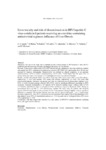Mostrar o rexistro simple do ítem
Liver toxicity and risk of discontinuation in HIV/hepatitis C virus-coinfected patients receiving an etravirine-containing antiretroviral regimen: influence of liver fibrosis
| dc.contributor.author | Casado, José Luis | |
| dc.contributor.author | Mena, Álvaro | |
| dc.contributor.author | Bañón, S | |
| dc.contributor.author | Castro-Iglesias, Ángeles | |
| dc.contributor.author | Quereda, C | |
| dc.contributor.author | Moreno, A | |
| dc.contributor.author | Pedreira, José D. | |
| dc.contributor.author | Moreno, S | |
| dc.date.accessioned | 2017-04-18T07:28:56Z | |
| dc.date.available | 2017-04-18T07:28:56Z | |
| dc.date.issued | 2015-06-30 | |
| dc.identifier.citation | Casado JL, Mena A, Bañón S, et al. Liver toxicity and risk of discontinuation in HIV/hepatitis C virus-coinfected patients receiving an etravirine-containing antiretroviral regimen: influence of liver fibrosis. HIV Med. 2016;17(1):62-67 | es_ES |
| dc.identifier.issn | 1464-2662 | |
| dc.identifier.issn | 1468-1293 | |
| dc.identifier.uri | http://hdl.handle.net/2183/18398 | |
| dc.description | Short communication | es_ES |
| dc.description.abstract | [Abstract] Objectives. The aim of the study was to establish the risk of liver toxicity in HIV/hepatitis C virus (HCV)-coinfected patients receiving etravirine, according to the degree of liver fibrosis. Methods. A prospective cohort study of 211 HIV-infected patients initiating an etravirine-containing regimen was carried out. HCV coinfection was defined as a positive HCV RNA test, and baseline liver fibrosis was assessed by transient elastography. Hepatotoxicity was defined as clinical symptoms, or an aspartate aminotransferase (AST) or alanine aminotransferase (ALT) value > 5-fold higher than the upper limit of normal if baseline values were normal, or 3.5-fold higher if values were altered at baseline. Results. Overall, 145 patients (69%) were HCV coinfected, with a lower nadir (165 versus 220 cells/μL, respectively; p = 0.03) and baseline (374 versus 498 cells/μL, respectively; p = 0.04) CD4 count than monoinfected patients. Etravirine was mainly used with two nucleoside reverse transcriptase inhibitors (129; 61%) or with a boosted protease inhibitor (PI) (28%), with no significant differences according to HCV serostatus. Transient elastography in 117 patients (81%) showed a median (range) stiffness value of 8.25 (3.5–69) kPa, with fibrosis stage 1 in 43 patients (37%) and fibrosis stage 4 in 28 patients (24%). During an accumulated follow-up time of 449.3 patient-years (median 548 days), only one patient with advanced fibrosis (50.8 kPa) had grade 3–4 liver toxicity (0.7%). Transaminases changed slightly, with no significant differences compared with baseline fibrosis, and nine and six patients had grade 1 and 2 transaminase increases, respectively. Also, HCV coinfection was not associated with a higher risk of discontinuation (25% discontinued versus 21% of monoinfected patients; p = 0.39, log-rank test) or virological failure (8% versus 12%, respectively; p = 0.4). Conclusions. Our data suggest that etravirine is a safe option for HIV/HCV-coinfected patients, including those with significant liver fibrosis. | es_ES |
| dc.language.iso | eng | es_ES |
| dc.publisher | Wiley | es_ES |
| dc.relation.uri | http://dx.doi.org/10.1111/hiv.12274 | es_ES |
| dc.rights | This is the peer reviewed version of the article which has been published in final form at Wiley Online Library. This article may be used for non-commercial purposes in accordance with Wiley Terms and Conditions for self-archiving | es_ES |
| dc.subject | Etravirine | es_ES |
| dc.subject | Hepatotoxicity | es_ES |
| dc.subject | Liver fibrosis | es_ES |
| dc.subject | Nonnucleoside reverse transcriptase inhibitor | es_ES |
| dc.subject | Transient elastography | es_ES |
| dc.title | Liver toxicity and risk of discontinuation in HIV/hepatitis C virus-coinfected patients receiving an etravirine-containing antiretroviral regimen: influence of liver fibrosis | es_ES |
| dc.type | info:eu-repo/semantics/article | es_ES |
| dc.rights.access | info:eu-repo/semantics/openAccess | es_ES |
| UDC.journalTitle | HIV Medicine | es_ES |
| UDC.volume | 17 | es_ES |
| UDC.issue | 1 | es_ES |
| UDC.startPage | 62 | es_ES |
| UDC.endPage | 67 | es_ES |
Ficheiros no ítem
Este ítem aparece na(s) seguinte(s) colección(s)
-
INIBIC-VC - Artigos [37]






